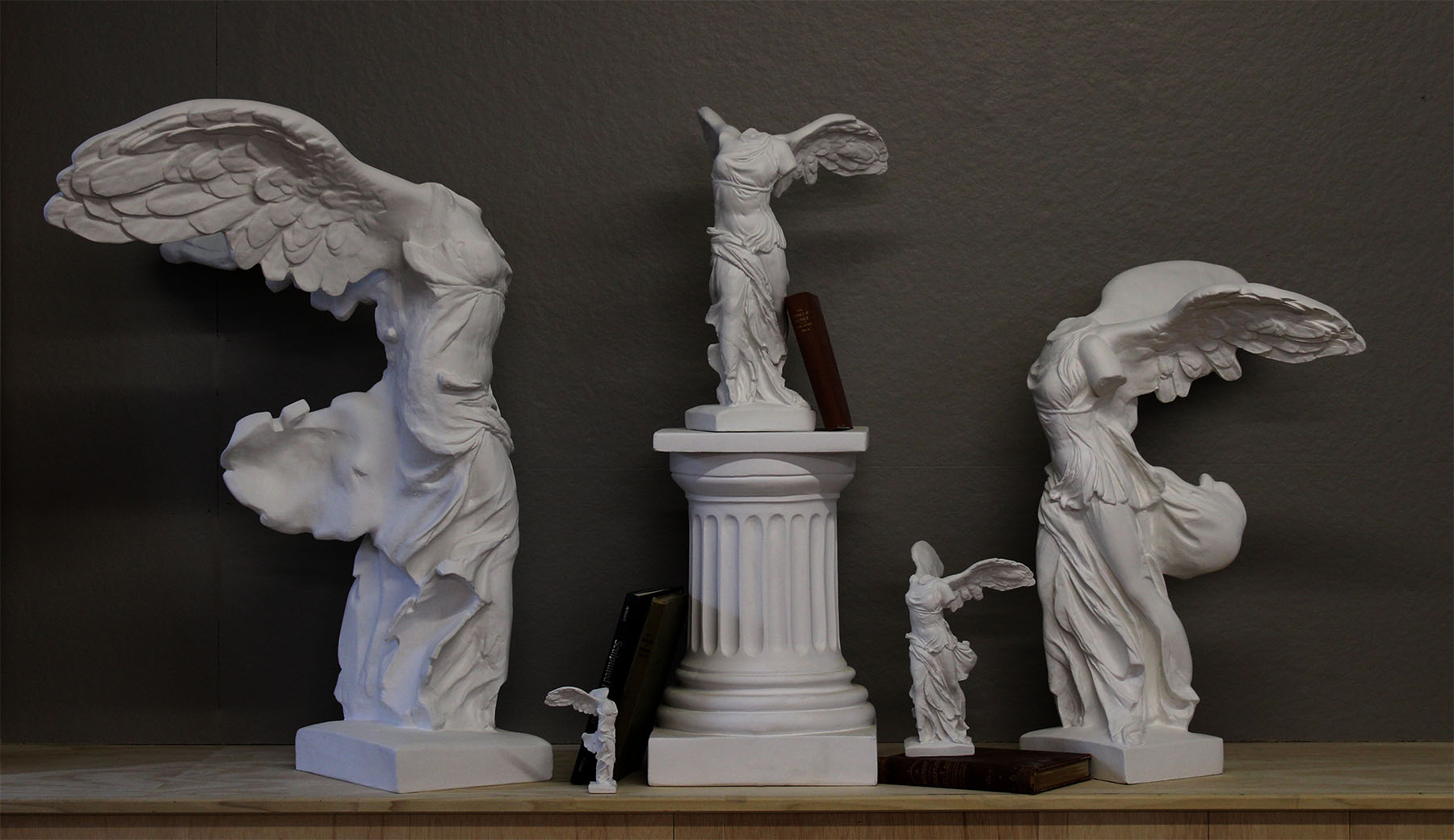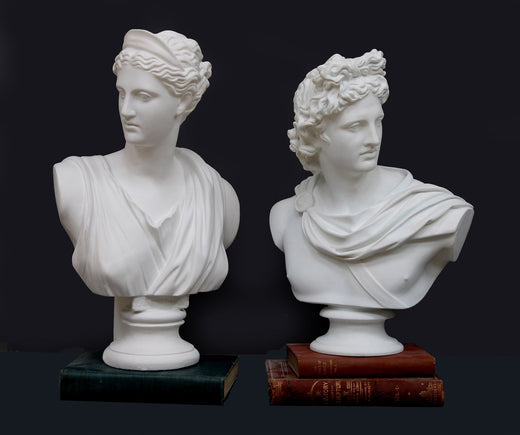The antique P.P. Caproni & Brother catalogs are works of art in themselves for many reasons. For those of you unaware, Boston-based P.P. Caproni & Brother is the Caproni Collection’s predecessor company. It was founded and run by two Italian brothers starting in the 1890s as a way to bring sculpture from around the world to the homes and schools of the American public. The company not only had to create high-quality molds and casts, but publish catalogs with information and images of thousands of pieces.
We love browsing the catalogs we have in our archives, and seeing the drawings and photographs of the sculptures and of the gallery. I also personally enjoy reading what the company wrote regarding its collection, its patinas, and other information it included. These catalogs and supplements, dating from 1894 to 1931, are also largely the only documentation we now have about the company’s past since most of its records were destroyed in a fire in the 1940s. We are thrilled when people and institutions contact us about a Caproni cast they own and its history if they have the records. If you have an old cast, we’d love to hear about it!

Scan of a page from “Catalogue of Caproni Casts — Catalogue of Plaster Reproductions from Antique, Medieval and Modern Sculpture, Subjects for Art Schools, Edition of 1911”
To further assess our history that stretches over one hundred years, I read through these antique catalogs to understand the company’s mission and values, and examined the similarities and differences from catalog to catalog. And I was not disappointed by my first in-depth look at these publications.
Photographs and Illustrations
Although for decades our company has used photographs of casts for its catalogs, the first few Caproni catalogs utilized both photographs and drawings. P.P. Caproni & Brother published its first two catalogs in 1894: one with only eight pages of images, and one with images of most, if not all, of the casts for sale. The former actually advertised the latter, which you can see in the scan below. The latter was illustrated by W.B. Russell of Boston.

Scan of illustrated edition advertisement from the 1894 “Catalogue of P.P. Caproni & Bro. — Catalogue of Plaster Cast Reproductions from Antique, Mediaeval and Modern Sculpture, Subjects of Every Description for Art Schools”

Scan of copyright page from the 1894 illustrated edition of “Catalogue of P.P. Caproni & Bro. — Catalogue of Plaster Cast Reproductions from Antique, Mediaeval and Modern Sculpture, Subjects of Every Description for Art Schools”
We assume the mixture of visuals was utilized because photography was expensive and the catalog was over 200 pages. The drawings are beautiful, with some more detailed than others, and the photographs are well-staged and lit.

Scans of pages from the 1894 illustrated edition of “Catalogue of P.P. Caproni & Bro. — Catalogue of Plaster Cast Reproductions from Antique, Mediaeval and Modern Sculpture, Subjects of Every Description for Art Schools”
In some catalogs, P.P. Caproni & Brother added photos of the gallery, including shots of the buildings and of the various rooms (see scanned catalog page of gallery photograph above). Their impressive displays surely drew in visitors.
Cast Information
Whether it might have been based on the ultimate size of the catalog or the publisher the company hired, the designs of the catalogs varied over the years. For some catalogs, the company would simply list the sculpture information (see below). The images, whether of all of the sculptures or a small selection, would be found elsewhere in the publication and would be captioned with item numbers and/or titles. For other designs, the company captioned the images themselves with all of the sculpture information (see below). On some pages in this catalog design, there was both a list and the images of the corresponding sculptures.

Photo of pages from “P.P. Caproni & Brother Catalogue of Sculpture — Catalogue of Plaster Cast Reproductions from Antique, Medieval and Modern Sculpture, Subjects for Art Schools, Edition of 1901”

Scan of a page from “Catalogue of Caproni Casts — Catalogue of Plaster Reproductions from Antique, Medieval and Modern Sculpture, Subjects for Art Schools, Edition of 1911”
Sometimes the identification the Caproni catalogs gave to a piece is the only information we have on that piece. If a sculpture is simply identified as “bracket” or “torso,” we have to rely on the image of the piece to help us research it further, which can be a difficult place to start. As I’ve been working my way through the collection researching each sculpture, I have discovered that some items were incorrectly identified as to title, sculptor, date of creation, or museum collection. We are planning to share images of unidentifiable pieces with you via social media so we have more eyes out there to help us!
Informational Pages
The company at times included in the catalogs information such as patina option descriptions, ordering instructions, services offered (like restoration and making casts of hands and feet), how to mount brackets and reliefs, and how to clean casts. (Note: These hanging and cleaning recommendations are no longer advised! Please contact us if you need assistance.)

Scans of pages from the 1928 “Caproni Casts: Reproductions of Sculpture Selected from the Masterpieces of the World, Part One”
The Caproni company also included a page or more in some publications to prove the quality of their casts over other makers. They speak passionately about the differences in side-by-side comparisons and also alert customers that some companies make recasts of their casts.

Scans of pages from the 1913 “Caproni Casts: Special Catalogue of Subjects for the Decoration of Schools, Libraries and Homes — Catalogue of Plaster Reproductions from Antique, Medieval and Modern Sculpture, Subjects Suitable for Schools, Libraries and Homes”
Caproni Values
One of our favorite aspects of the catalogs is when the company wrote an introduction. Below are two different ones, from the 1911 and 1928 catalogs, respectively. They both touch on the ability of a reproduction to be its own work of art, the source of the company’s molds, the company’s high-quality materials and workmanship, and the hallmark embedded in each cast. The later 1928 catalog includes a note on P.P. Caproni & Brother’s reputation before also heading into informational text.

Scans of pages from “Catalogue of Caproni Casts — Catalogue of Plaster Reproductions from Antique, Medieval and Modern Sculpture, Subjects for Art Schools, Edition of 1911” and the 1928 “Caproni Casts: Reproductions of Sculpture Selected from the Masterpieces of the World, Part One”
We enjoy reading these introductions and anything else the company wrote in its catalogs because it is all we have left in order to understand their mission and values. It is clear the Caproni company took great pride in the casts they made from molds they created of original works of art. We at the Caproni Collection aim to keep alive the respect for plaster casts by creating high-quality casts, educating others on the history and the techniques, and sharing our passion.
___________________
I hope you enjoyed this account of the historic catalogs. Take a look at the catalogs we scanned and posted on our website to explore them further. If you own a Caproni or Giust Gallery cast, you can see how it was marketed and what it cost one hundred years ago. If you need help finding it, let us know!
Best,
Kayla


Comments
Hello Peggy,
How interesting! It’s great to hear about the people who worked for the company!
Best,
Kayla Fletcher
I believe my ancestor, Giovanni Castagnoli, worked for them when he first moved here from Florence, Italy, in the 1890s. At least his son mentioned it in his memoir about his parents. It was nice to find this. Peggy
Hello Brian,
We are going to email you about this, too. The Caproni Galleries stamp was used from the mid-1930s to mid-1950s. The Caproni Galleries did not produce catalogs at this time (or save records) so we do not know what the pieces sold for. If you email us photos of your pieces, we can help you determine their value.
Best,
Kayla Fletcher
I believe I have two 1930 angel figurines. They both have the metal Caproni Galleries Inc stamp at the bottom of them. They have no eyes. Just wanting to know if they were made in 1930? If not, then what year? How much did they sale for in 1930 and how much do you think they are worth now? I also have an angel figurine from a navity set . H23. Wondering what year was this made in?